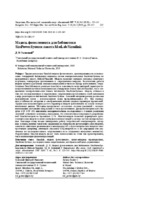Модель фотоэлемента для библиотеки SimPowerSystems пакета MatLab/Simulink
Another Title
Model of a Photovoltaic Cell for the MatLab/Simulink SimPowerSystems Library
Bibliographic entry
Зализный, Д. И. Модель фотоэлемента для библиотеки SimPowerSystems пакета MatLab/Simulink = Model of a Photovoltaic Cell for the MatLab/Simulink SimPowerSystems Library / Д. И. Зализный // Энергетика. Известия высших учебных заведений и энергетических объединений СНГ. – 2019. – № 2. – С. 135-145.
Abstract
Предложена новая Simulink-модель фотоэлемента, ориентированная на использование стандартной библиотеки элементов систем электроснабжения SimPowerSystems из программного пакета MatLab/Simulink. Модель позволяет изменять значения солнечного излучения, температуры фотоэлемента и сопротивления нагрузки. Результатами работы модели являются расчетные значения напряжений и токов на выходе фотоэлемента. Разработанная Simulink-модель реализует известную зависимость вольт-амперной характеристики фотоэлемента путем использования как стандартных блоков MatLab/Simulink, так и специальных электротехнических блоков библиотеки SimPowerSystems. Модель отличается тем, что последовательное и параллельное сопротивления фотоэлемента в ней выполнены в виде резисторов из библиотеки SimPowerSystems. Основной алгоритм расчета реализован программным путем с использованием языка программирования «С». Для повышения устойчивости алгоритма к алгебраическим циклам введены параметры ограничений. Предложена новая методика расчета параметров модели фотоэлемента на основе экспериментальных данных. Методика предполагает составление системы уравнений с экспериментальными значениями напряжений и токов фотоэлемента. Для фотоэлектрического модуля OSP XTP 250 выполнены экспериментальные исследования в условиях различных значений солнечного излучения, показавшие, что относительная погрешность разработанной Simulink-модели не превышает 12 %. Simulink-модель позволяет формировать фотоэлектрические модули и затем схемы фотоэлектростанций в составе систем электроснабжения. Благодаря этому можно имитировать работу потребителей электроэнергии, погодные условия, наличие теней или загрязнения на поверхности фотоэлектрических модулей, выполнять имитацию развивающихся неисправностей в фотоэлектрических модулях электростанции (например, имитацию снижения КПД модулей из-за их деградации или увеличение их последовательного сопротивления из-за ухудшения внутренних контактов). Разработанная Simulink-модель может быть использована на этапе как проектирования, так и эксплуатации фотоэлектростанций.
Abstract in another language
A new Simulink model of a photovoltaic cell has been proposed. The model is focused on the use of a standard SimPowerSystems library with power engineering elements from the MatLab/Simulink software package. The model allows altering the values of solar irradiance, photovoltaic cell temperature and load resistance. The results of the model application are the calculated values of voltages and currents at the photovoltaic cell output. The Simulink model that has been developed implements the known dependence of the photovoltaic cell volt-ampere characteristic by using both standard MatLab/Simulink blocks and special electric SimPowerSystems library blocks. The model is characterized by the fact that the series and parallel resistance of the photovoltaic cell are made in the form of resistors from the SimPowerSystems library. The main calculation algorithm is implemented programmatically by using the “C” programming language. To increase the algorithm stability to algebraic cycles the restrictions parameters are introduced. A new technique of calculating the photovoltaic cell model parameters based on experimental data has been proposed. The technique includes the preparation of a system of equations with experimental values of the photovoltaic cell voltages and currents. Experimental tests have been carried out for the photovoltaic module OSP XTP 250 under different solar irradiance values. The tests showed that the relative error of the Simulink model that has been developed does not exceed 12 %. The Simulink model makes it possible to build photovoltaic modules and then to build schemes of photovoltaic power plants as a part of power supply systems. Due to the latter it is possible to simulate the electricity consumers’ work, weather conditions, and the presence of shadows or pollution on the surface of photovoltaic modules. Also, one can carry out a simulation of increasing failures in power plant photovoltaic modules, e.g. simulating of modules efficiency reducing because of their degradation, or simulating of modules series resistance increasing because of the photo-voltaic cell internal contacts deterioration. The Simulink model that has been developed can be used both at the design stage and at the stage of photoelectric power plants operation.
View/
Collections
- № 2[8]

